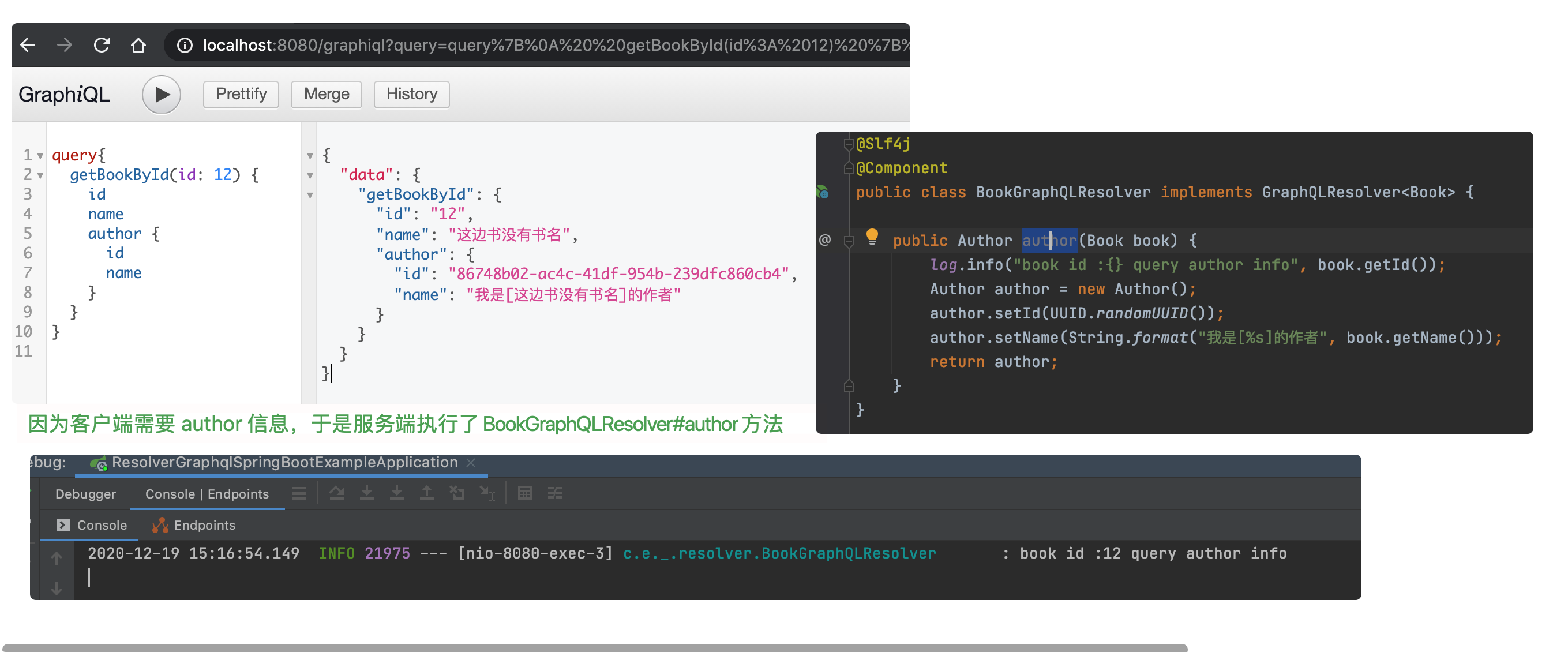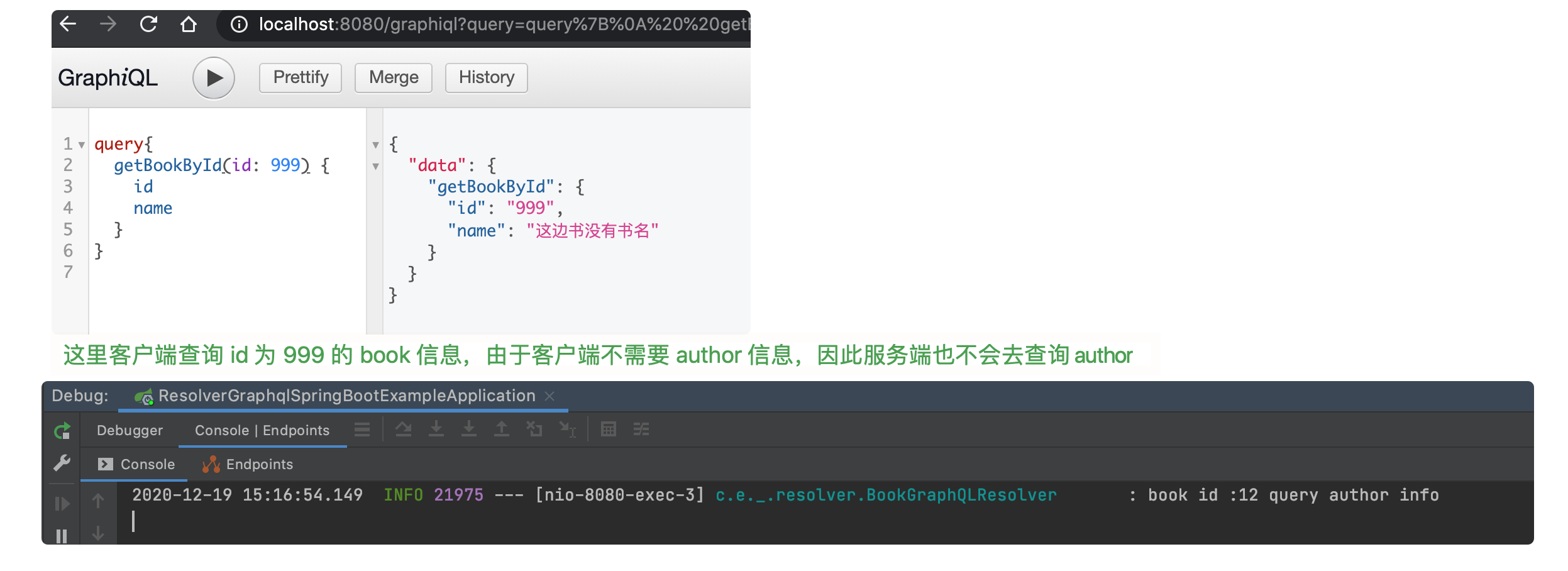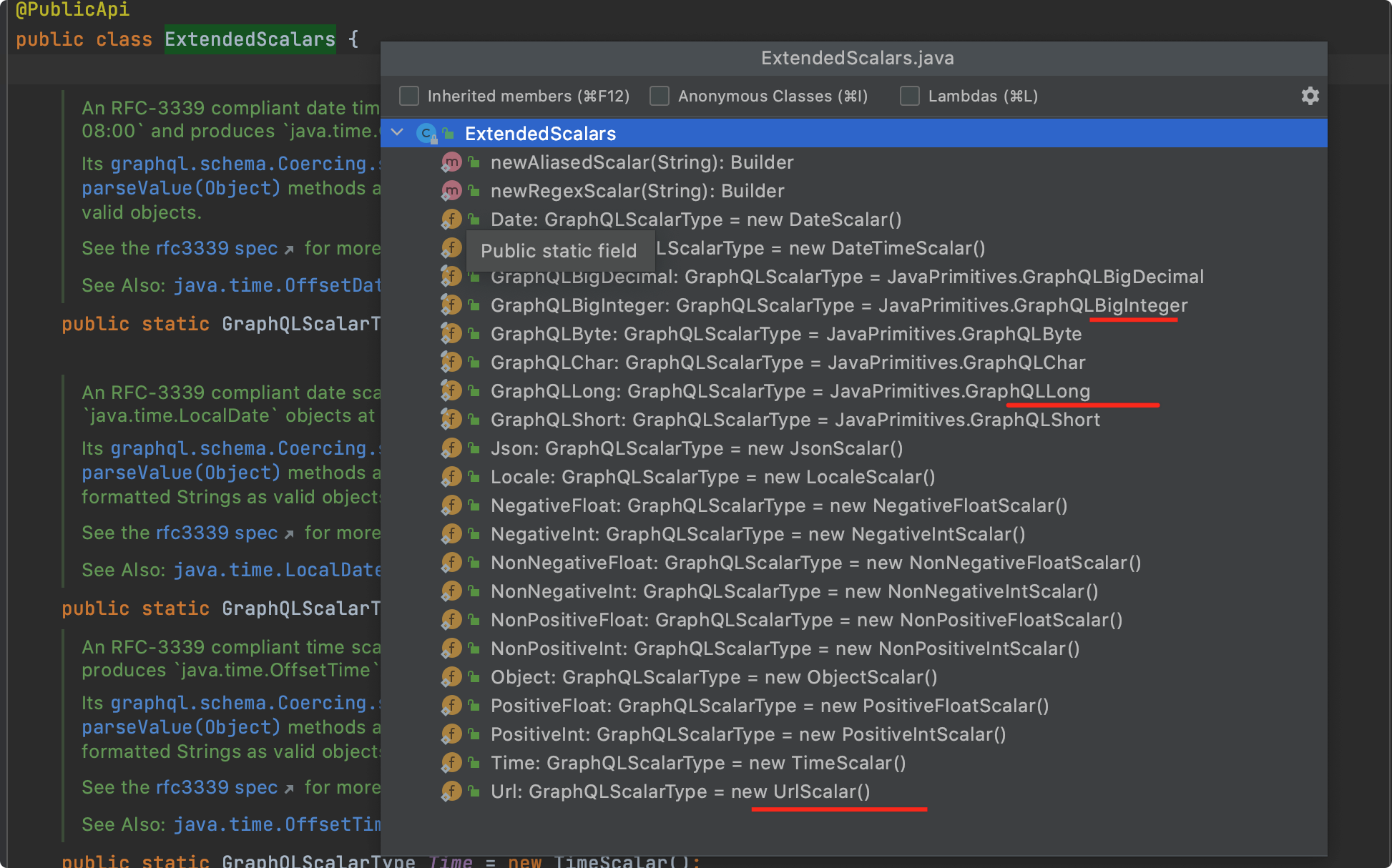hello,大叫好,我是小黑,又和大家见面啦~
今天我们来继续学习 Spring Boot GraphQL 实战,我们使用的框架是 https://github.com/graphql-java-kickstart/graphql-spring-boot
项目 github 地址:https://github.com/shenjianeng/graphql-spring-boot-example
Query(查询)
带参数的查询
首先,在 classpath 下创建 graphqls 文件:
type Book{
id:ID!
name:String!
}
type Query{
# 根据 id 查询 book,参数名为 id,参数类型的 ID 类型,结果返回 book
getBookById(id:ID!):Book
}
创建一个 Spring Bean,此处需要实现 GraphQLQueryResolver 接口,并在该类中自定义一个方法来映射 graphqls 文件中的查询。
@Data
public class Book {
private int id;
private String name;
}
@Component
public class BookGraphQLQueryResolver implements GraphQLQueryResolver {
public Book getBookById(int id) {
Book book = new Book();
book.setId(id);
book.setName("这边书没有书名");
return book;
}
}
复合字段查询
需求:每本书都有作者,在查询书本信息时,有时需要返回作者信息。
# 定义 Author 数据类型结构
type Author{
id:ID!
name:String!
}
type Book{
id:ID!
name:String!
# 增加 author 字段,数据类型为 Author
author:Author
}
type Query{
# 根据 id 查询 book,参数名为 id,参数类型的 ID 类型,结果返回 book
getBookById(id:ID!):Book
}
再看一下此时我们的 Java Bean:
@Data
public class Author {
private UUID id;
private String name;
}
@Data
public class Book {
private long id;
private String name;
}
看仔细哦,Book 类中并没有 author 字段,Book 中 author 信息将由 graphql.kickstart.tools.GraphQLResolver 来提供。
@Slf4j
@Component
public class BookGraphQLResolver implements GraphQLResolver<Book> {
public Author author(Book book) {
log.info("book id :{} query author info", book.getId());
Author author = new Author();
author.setId(UUID.randomUUID());
author.setName(String.format("我是[%s]的作者", book.getName()));
return author;
}
}
ok,让我们启动服务,访问 http://localhost:8080/graphiql

而当客户端不需要 author 信息时,服务端就不会执行 BookGraphQLResolver#author,真正做到了使得客户端能够准确地获得它需要的数据,而且没有任何冗余。
(ps:如果你是服务端开发,你会怎么实现呢?是给客户端提供一个接口返回 book 和 author 信息,还是给客户端提供两个不同的接口呢?)

Mutation(变更)
在 graphqls 文件中,使用 Query 来定义查询接口,使用 Mutation 可以定义变更数据的操作。
type Mutation{
createBook(id:ID!,name:String!):Book
}
上述 graphqls 文件中定义了一个 createBook 的方法,参数列表为 id 和 name ,方法返回创建的 Book 对象。
与之对应的 Java 代码如下:
@Component
public class BookGraphQLMutationResolver implements GraphQLMutationResolver {
public Book createBook(int id, String name) {
Book book = new Book();
book.setId(id);
book.setName(name);
return book;
}
}
BookGraphQLMutationResolver 实现了 graphql.kickstart.tools.GraphQLMutationResolver 接口,表明当前类中的方法用来映射 graphqls 文件中的 Mutation。

Input Types
当 Mutation 中请求参数特别多时,我们可以使用 Input Types 来优化代码。
type Mutation{
createBook(id:ID!,name:String!):Book
create(bookInput:BookInput!):Book
}
input BookInput{
id:ID!
name:String!
}
同理,我们也需求在 BookGraphQLMutationResolver 中添加对应的方法来映射。
@Component
public class BookGraphQLMutationResolver implements GraphQLMutationResolver {
// ...省略其他代码
public Book create(BookInput input) {
Book book = new Book();
book.setId(input.getId());
book.setName(input.getName());
return book;
}
}
客户端请求代码如下:

自定义标量类型
在 GraphQL 中自带一些默认标量类型:
-
Int:有符号 32 位整数 -
Float:有符号双精度浮点值 -
String:UTF‐8 字符序列 -
Boolean:true或者false -
ID:ID 标量类型表示一个唯一标识符,通常用以重新获取对象或者作为缓存中的键。ID 类型使用和 String 一样的方式序列化
使用 graphql-java-extended-scalars 库
在 Java 这个生态中,我们可以引入下面这个库来帮助我们很方便的进行扩展:
https://github.com/graphql-java/graphql-java-extended-scalars
<dependency>
<groupId>com.graphql-java</groupId>
<artifactId>graphql-java-extended-scalars</artifactId>
<version>15.0.0</version>
</dependency>
graphql-java-extended-scalars 中具体扩展了哪些标量类型,我们都可以在 graphql.scalars.ExtendedScalars 类中找到。
(ps:一个小技巧,s 结尾的类一般都是工具类)

如何使用呢?
- 向 Spring 容器中注册自定义标量
- 在 graphqls 文件中声明要使用的自定义标量
- 直接使用即可
相关示例代码如下:
@Configuration
public class CustomScalarTypeConfig {
@Bean
public GraphQLScalarType graphQLLong() {
return ExtendedScalars.GraphQLLong;
}
}
scalar Long
type Book{
id:ID!
name:String!
# 增加 author 字段,数据类型为 Author
author:Author
totalPageSize:Long
}
使用 GraphQLScalarType 自定义标量类型
我们可以参考 graphql.scalars.java.JavaPrimitives#GraphQLLong 的实现来自定标量类型。
@Bean
public GraphQLScalarType graphQLDate() {
return GraphQLScalarType
.newScalar()
.name("Date")
.description("Date 类型")
.coercing(new Coercing<Date, String>() {
@Override
public String serialize(Object dataFetcherResult) throws CoercingSerializeException {
return new SimpleDateFormat(DATE_FORMAT_PATTERN_DEFAULT).format((Date) dataFetcherResult);
}
@Override
public Date parseValue(Object input) throws CoercingParseValueException {
if (input instanceof String) {
try {
return new SimpleDateFormat(DATE_FORMAT_PATTERN_DEFAULT).parse((String) input);
} catch (ParseException e) {
throw new CoercingParseValueException(e);
}
}
throw new CoercingParseValueException(
"Expected a 'String' but was '" + Kit.typeName(input) + "'."
);
}
@Override
public Date parseLiteral(Object input) throws CoercingParseLiteralException {
if (!(input instanceof StringValue)) {
throw new CoercingParseLiteralException(
"Expected AST type 'StringValue' but was '" + typeName(input) + "'."
);
}
try {
return new SimpleDateFormat(DATE_FORMAT_PATTERN_DEFAULT).parse(((StringValue) input).getValue());
} catch (ParseException e) {
throw new CoercingParseValueException(e);
}
}
})
.build();
}
DataFetcherResult
在 Resolver 中,我们可以使用 graphql.execution.DataFetcherResult 来包装返回的结果,示例代码如下:
@Component
public class BookGraphQLQueryResolver implements GraphQLQueryResolver {
public DataFetcherResult<Book> getBookById(int id) {
if (id <= 0) {
return DataFetcherResult
.<Book>newResult()
.error(new GenericGraphQLError("id 不能为负数"))
.build();
}
Book book = new Book();
book.setId(id);
book.setName("这边书没有书名");
return DataFetcherResult
.<Book>newResult()
.data(book)
.build();
}
}
下期预告
下期我们将使用 graphQL 来实现分页,并介绍一些高级特性,例如:异步加载、全局异常处理等。感谢大家的关注和阅读~~
更多学习参考资料:
https://www.graphql-java-kickstart.com/tools/schema-definition/#resolvers-and-data-classes